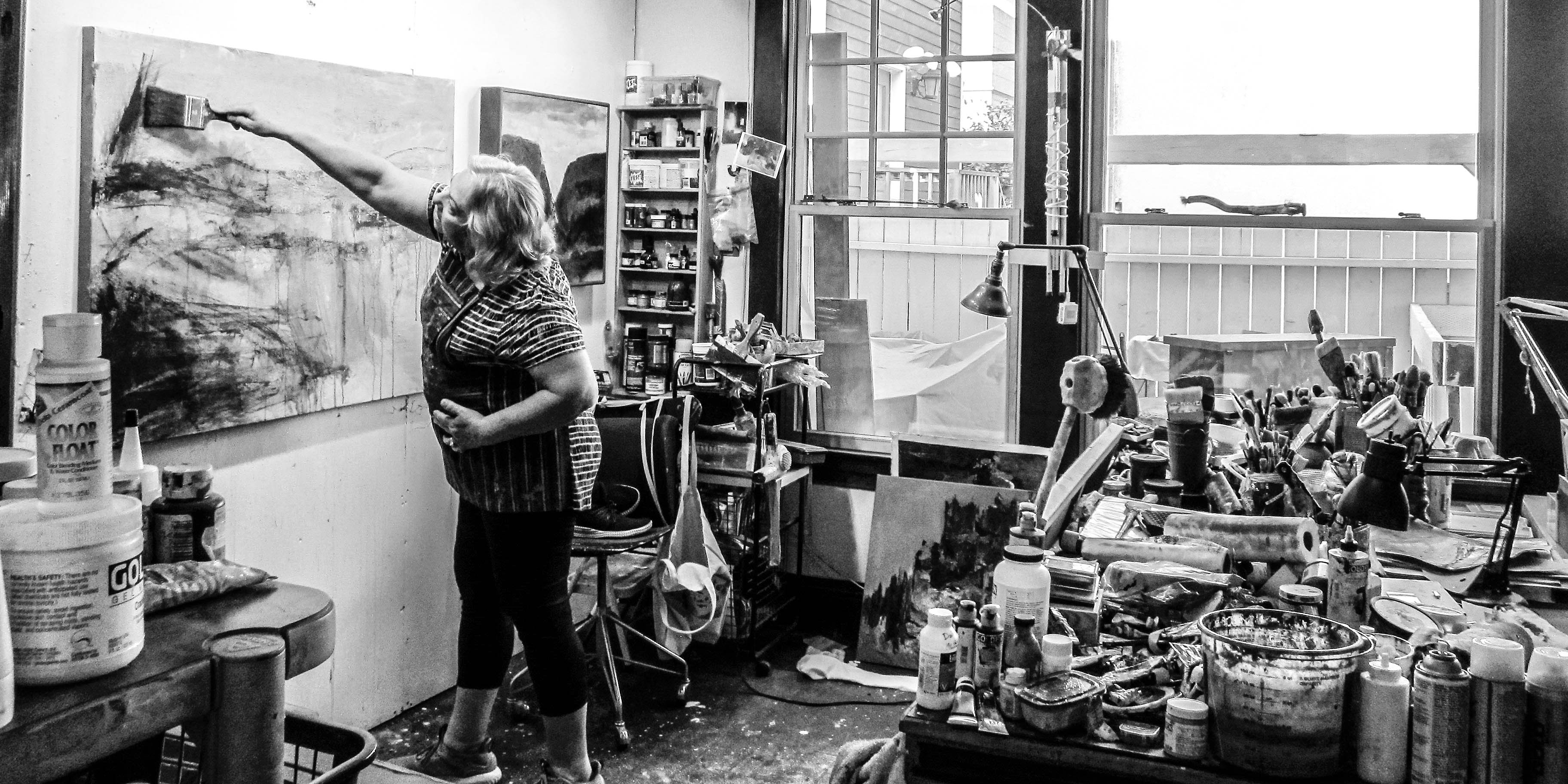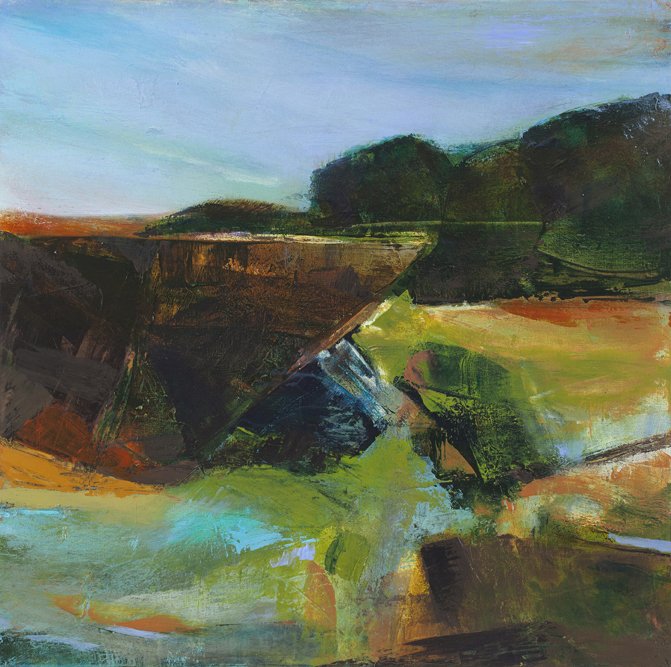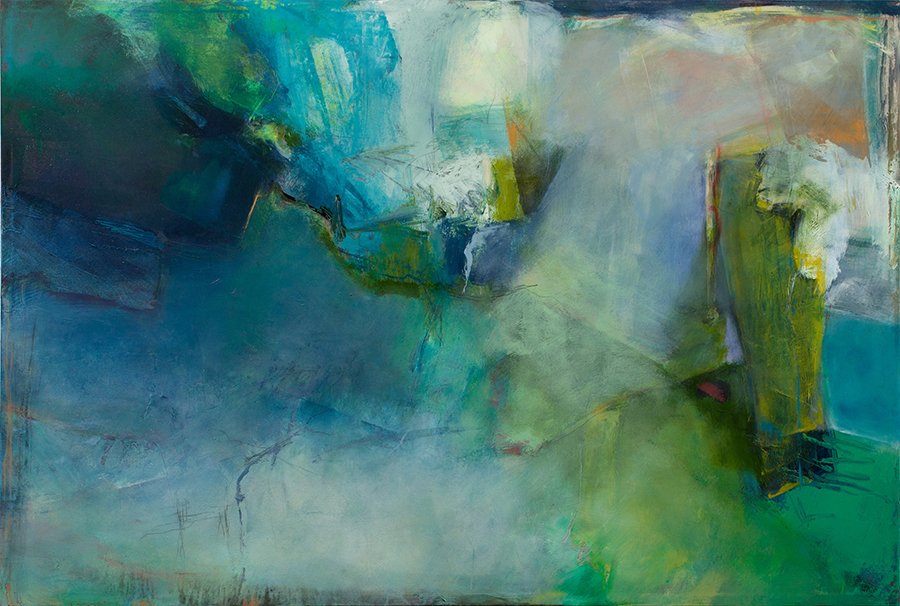ArtHouse 23’s JoAnn Gilles


ELEVEN: What is ArtHouse 23? Can you tell us a little about the history of the house, how you acquired it and the conception of the idea?
JoAnn Gilles: ArtHouse 23 is a place for painting and process designed to foster creativity and community with a complete lack of competitiveness or conflict. As an artist who took a long time to answer the call to paint, when I finally braved having a studio of my own I felt stunted by the isolation. It’s tricky because creating a vision requires self-reflection, which requires solitude. But with no dialogue, a too-narrow focus is all too easy. I was lucky to find a community studio in the ‘90’s that, for a while, struck the perfect balance. But ultimately it imploded because of rivalry. As a near-evangelist for what creative endeavor can bring to life, I searched for like-minds and found few. So I set out to create a community of artists, starting by creating the artists.
In a “borrowed” gutted Victorian in SW Portland, with little more than a kitchen sink bolstered by a makeshift counter, ten women without formal art education gathered to pursue meaning by learning to draw and paint. As the leader of this “band of sisters” I was determined to develop an environment and a curriculum that allowed each person to glean whatever she needed from a weekly art class in hopes of an evolution into a group of art mavens. Together we produced and celebrated art so individual that it was impossible to tell that the resulting paintings came from the same exercise and the same subject on the same night. It was eye-opening and exciting. It fueled my work. They became pros.

Word spread, experienced artists joined and we soon occupied a large space in the NW Seed building. It had all the romance of beams, bricks and light of an industrial art space. It was big and expensive and cold in winter. Although the landlord was terrific, I hated paying rent.
The search for a large enough space led to this 6,700 sq ft historic house built for a Chinese healer in 1909. At the time, it was owned by a Baptist ministry that used it as a halfway house for recovering addicts. It was in rough shape. But they had built a very large, open room for their “church” in the back–it was perfect for our studio.
With the help of a supporter, I was able to buy this notable, majestic structure that functioned as a place of healing and spirituality throughout its history. It seemed appropriate to continue the tradition through art, upgrading its structure little by little.

11: What is the process like in gaining resident artists for this creative space? How many artists do you offer creative space for and what types of artists do you house?
JG: There are 30 artists who make up ArtHouse 23 who found it by word-of-mouth. They come weekly for a three-hour painting session that may include art history talks or a creative exercise. Twelve or so rent space in the house–everything from a corner to call their own to a whole room. Two other artists, with whom I shared studios with in the past, also rent space but don’t participate in the community. Everyone is a painter, although media varies.
11: Can you elaborate on how ArtHouse 23 situates itself in the neighborhood and weaves its way into the community? What is it that this space offers that makes it so unique?
JG: We just happened upon this house in a convenient location that seemed workable. But since we purchased in 2006, the Eliot neighborhood has gentrified rapidly. It is a mix of commercial and residential, however it has grown with an affinity for “outside-the-box” neighbors. Williams Avenue history of jazz is commemorated with street signs and in Billy Webb’s Elks lodge around the corner. PICA (Portland Institute for Contemporary Art), moved in across the street. Painter and printmaker William Park is around another corner, he and I co-taught printmaking to a group from ArtHouse 23. One neighbor is a writer and two other families of artists live on the street. NW Documentary is just behind us. Although there may be little day-to-day interaction, there is a consciousness that “heart” is at the root of what goes on inside neighboring walls. My brother-in-law, Jesse, who is a woodworker, lives in the lower level apartment. He makes frames for many of the artists as well as his own wood creations.
In the house there is a fireplace room lined with art books available to all. Although there are no cooking facilities, the main floor kitchen has a large commercial sink where we can scrub paintings as part of the process, make coffee or heat up lunch. In the classroom studio we have shared resources like mediums, cleaners, paper-cutters, light table, tools, still-life and reference materials, as well as a projector for art videos, which we enjoy frequently.
As a group, in one configuration or another, we may visit galleries, PICA or museums (here and in other cities). Our weekly evening gathering is also a potluck, and there is always a bottle of wine in the fridge. We share proceeds from our annual open studio in the support of a local charity. This year we are partnering with CHAP, Children’s Healing Art Project that “brings the healing power of art to children and families facing medical challenges.”

11: You are both the founder and an artist yourself! Much of your work would be considered abstract paintings, though some of your pieces seem to take definite form. What captivates your creative mind and beckons your creative expression? What inspires your pieces or influences your brushstrokes? Has the Chinese history of this house influenced you knowingly (or unknowingly)?
JG: Despite being inspired by a wide range of subjects, including the figure, rocks, water, weather, dead birds, shriveled plants or eviscerated bats (I have one), I’ve concluded that it’s always about the landscape for me. Landscape is more than just a peaceful scene. It is a record of the Earth and its inhabitants, for good or ill. It nourishes. It shapes us. It separates and connects us. And unfortunately, it can harm us as we are not always good stewards. I’m drawn to exploring it in different ways.
My latest body of work looks at “residual beauty”–how places scarred with abuse and unrest, like the Pennsylvania coal mines, (where my family is from) and the trespassed Malheur Wildlife refuge (which infuriated me)–can retain a reassuring exquisiteness. My current painting began with a modeling session with Autumn, our amazing model. It is already on the way to being something I do not yet know, but it will likely involve a sky.
I can’t say that the Chinese motifs that are integrated into the design of the house, like the yin/yang symbol carved in the stairwell, have influenced me. But I sense the spiritual nature of the place. And, coincidentally, much of the furniture we bought long before moving here is rustic Chinese. So there’s something about the aesthetic that fits, although I am not Asian, at least, not that I know of.
11: Where did your creative talents originate? Do you have formal art training or are you a self-taught artist? Have you always been a painter, or have you worked in other mediums?
JG: As a child my box of colors was the most valuable thing to me. But it took over 30 years to have the courage to commit to using them on a regular basis. I graduated from PSU with a degree in design and an art teaching certificate (Had to keep it practical). Two teachers I found in my 30’s made me believe I am a painter and I am forever grateful. I have experimented with many crafts and media, but dancing with a brush always is preferred.

11: What about your creative process has influenced your design and execution of ArtHouse 23 as a community of creative individuals?
JG: I’m very much a believer in the power of process and I’m absolutely convinced that turning myself over to it is the best way to cultivate vision, meaning and expression. And, if motivated, anyone can develop their own visual language and tell their tale in the same way. It is centering, life affirming and stimulating. More than any learned ability, it takes trust, being comfortable with ambiguity and patience. Once you experience that connection to the internal, and your unique articulation speaks to the viewer, it is exhilarating.
When people say they would like to paint but can’t draw, I’m so sad. Drawing is a great skill, a helpful skill and maybe a necessary skill at some point. But it can have little to do with creative expression. If you are willing to explore vague and challenging territory without needing to show a “product” in the end, it WILL come together. I’ve got proof!
I offer guidance, encouragement and creativity exercises. I facilitate coming together in three weekly, separate paint sessions, room for ten people in each. People can switch days if there is room. An environment that is bright, warm and comfortable with great lighting and not too much dirt is also part of the picture.
11: What benefits do you see with artists working both in close proximity and collaboratively with one another? Are there ever any difficulties that arise from this arrangement?
JG: An example: Just walking in from watering flowers I bumped into a studio-mate. He shared an “ah-ha” painting moment he just experienced. I related it to taking a mental journey I just took during a medical procedure. Both stories revealed how elusive, yet magical, tapping into the unconscious is, how painting continually affords that opportunity, and how aspects of life weave into the painting process. The conversation was maybe five minutes, but it touched deep subjects we understood on multiple levels. Sharing these ideas over the years, we resonate on a similar frequency. In a traditional studio these are missed moments that proximity provides. Borrowing, lending a “shoulder,” getting and giving feedback and a shared sandwich is always nice too. We’ve been at this location since 2006 and the only issue I can recall is when our old dog peed on someone’s reading chair.
11: You emphasize the importance of “community” in the success and prosperity of this space. Can you elaborate on what that means for ArtHouse 23?
JG: Whether mindful of it or not, each person values and contributes to a nurturing environment. The space is loved and respected. People pitch in with chores and supplies. The group offers a support system even when it is not overt. We teach and learn from each other. It is so much more about affirmation and joy. The art-making sometimes can feel like a by-product of the atmosphere.

11: You also live above this creative space on the top floor of the house. What is that experience like for you as the owner, permanent tenant and fellow artist?
JG: We never intended to live here. But the third floor “servant’s quarters,” turned apartment, was too delicious to resist. It’s shabby chic with exposed bricks and beams and seven skylights. The rooftop deck made it really something special. Our quarters are completely private, and no one would ever infringe. We hear people come and go, but it’s a subtle, friendly sound whatever time of day. I can always tell who it is by the rhythm of their footsteps. And it always makes me smile because I know they are happy to be here. I get a lift when I hear the door open when I’m painting. I know whoever is there will provide a welcome break.
11: Does ArtHouse 23 have any upcoming events or workshops? Where can we find the work of ArtHouse 23’s artists?
JG: We rarely ever have workshops any more. Our space is limited and quite full. But we’d love to have folks visit during our annual open studio and share refreshments, see the space, the house built for Dr. Leo G Wo and the much-varied art that is created here. DATE: Saturday and Sunday, September 28 and 29. Hours are 2:00-7:00 on Saturday and 12:00-3:00 on Sunday.
We had our own gallery in Milwaukie for several years until the owner got inspired to use the space for her personal studio, and I showed at Mark Woolley Gallery until the lease was lost. So now artists show at varying venues, including curated group shows and online at Saatchi and their own websites. There is an ArtHouse 23 Facebook page and you can find us on Instagram. Currently you can see art at Stoller Vineyards, Tint Salon and then the Northeast ReMax Annual Art Show, coming up in October.
Find this artist online:
JoAnne Gilles: www.joanngilles.net
ArtHouse 23: www.arthouse23.com




